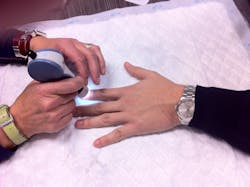Optical sensor-driven device can count white blood cells through the skin
An international team of researchers has developed a portable device for placing on the fingertip that counts white blood cells without a blood test. The technology—which combines an optical sensor with algorithms—is designed for use on chemotherapy patients, who could know their immune system levels in real time. It could also have utility in detecting serious infections.
The project, known as Leuko, has been financed by Madrid-MIT M+Visión, a consortium that seeks to foster collaboration between research centers and hospitals in the region of Madrid with the Massachusetts Institute of Technology (MIT; Cambridge, MA) and other centers in the Boston area. The Center of Future Technologies in Cancer Care and the Coulter Foundation are also supporting the project, and the total amount raised has been close to $450,000 (400,000 euros).
Carlos Castro, an engineer specializing in biomedicine who is working in the Research Laboratory of Electronics at MIT, says that the new device will allow white blood cells to be measured simply and painlessly. "Patients undergoing chemotherapy will be able to use a 'leukometer' in the future to estimate the state of their immune system," he adds, pointing out that the technology opens up the possibility to personalize chemotherapy treatment according to the immunological response for each patient. In the case of patients with lymphomas and leukemia, treatment doses could be maximized for each individual without compromising their immunological system. Treatment efficiency could be improved while reducing the risk of suffering serious infections, he says.
The technology includes a portable optical system, which provides oblique illumination with LEDs and is able to capture images of superficial capillaries under the skin with cellular resolution. The acquired videos are subsequently analyzed by automatic algorithms capable of detecting white blood cells and calculating their concentration. These algorithms, which have been protected by a patent filing, were presented at the Annual International Conference of the IEEE Engineering in Medicine and Biology Society, held August 25-29, 2015, in Milan, Italy.
Castro explains that the device is placed on the patient's fingertip in a similar way to how pulse oximeters are used in hospitals to measure blood oxygen levels. With a small lens, the system captures images of capillaries very close to the surface in the nailbed. When illuminating at certain frequencies, light is absorbed by the hemoglobin in the red cells, an effect that does not happen with the white cells. This means that the leukocytes appear as small transparent particles moving inside the capillary. Subsequently, the project's image processing algorithms recognize these events and count them, providing an estimate for their concentration in the blood, he adds.
The portable device will allow patients to carry out these measurements at home in the future, so it will no longer be necessary for them to travel to a hospital or clinic. Castro says that other medical areas where the device could have use is preventing sepsis and early diagnosis of a bacterial or viral infection.
There are currently three different prototypes. One of them is a portable microscope that is placed manually on the patient's finger to take videos of their microcirculation in very superficial capillaries. This device has already been tested on 31 patients in Hospital Fuenlabrada in Madrid and on six more in Massachusetts General Hospital in Boston. "We are now working to improve its accuracy and reliability," Castro says.A second version of the prototype includes modifications to the microscope to improve the stability and quality of the images. The third one is a small optical piece that can be added to a mobile phone camera to obtain images of the circulation in the capillaries. "These images could then be transmitted to a server where the algorithms would analyze them and give an estimate from the analysis," according to Castro.
Castro thinks that by the beginning of 2017, an initial beta product could be available for people willing to try it through crowdfunding platforms such as Indiegogo. With sufficient funding, the research team could develop a final product that meets European regulations by the beginning of 2019.
For more information, please visit http://mvisionconsortium.org/portfolio-item/team-leuko.

